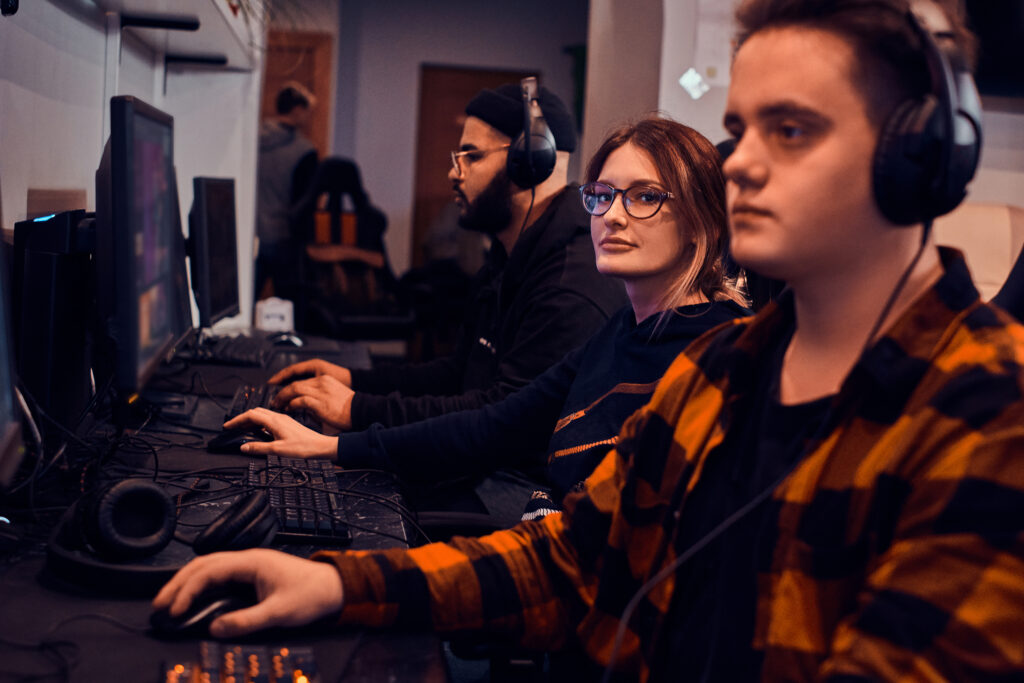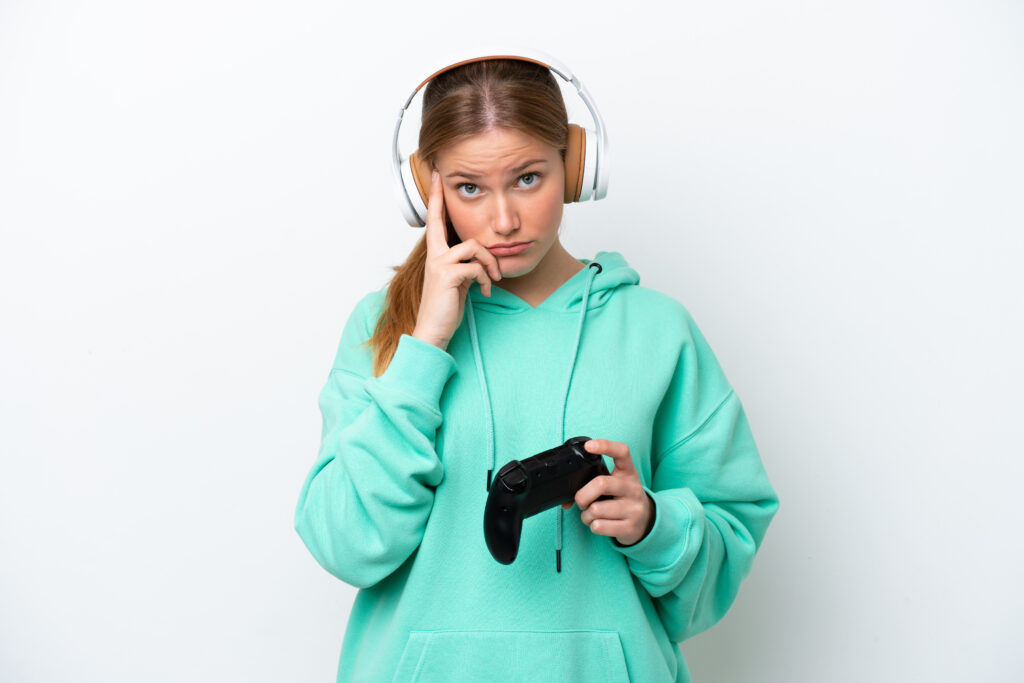Table of Contents
- Consequences of Video Game Addiction
- What is Video Game Addiction?
- Prevalence of Video Game Addiction Among Teenagers
- Symptoms of Video Game Addiction
- Tips for Limiting Teen’s Gaming Intake
- Encouraging Alternative Hobbies and Interests
- Key Takeaways

Video games have become an integral part of the lives of many adolescents, offering entertainment, social interaction, and sometimes even an escape from reality.
While gaming can be a healthy and enjoyable pastime, it can turn into a harmful addiction, and its consequences on a teenager’s physical, mental, and social well-being are significant.
In this guide, I explain the consequences of gaming addiction, what it is, its prevalence and symptoms, negative effects, tips for limiting this behavior, and suggested alternative activities.
Consequences of Video Game Addiction
Identifying video game addiction in teenagers is important because it can have adverse effects on their physical health. Prolonged hours of gaming often lead to a sedentary lifestyle, resulting in obesity and related health issues.
Moreover, insufficient sleep and poor eating habits can emerge as teenagers prioritize gaming over their basic health needs.
Mental health concerns are another major reason to recognize and address video game addiction. Excessive gaming can contribute to heightened stress, anxiety, and depression, as it often fosters social isolation and hinders emotional development.
The constant need for in-game rewards can lead to a sense of inadequacy and lower self-esteem when unmet, creating a cycle that is hard to break without intervention.
Video game addiction can also disrupt a teenager’s social life and academic performance. Neglecting schoolwork and face-to-face relationships in favor of online gaming can result in academic underachievement and strained interpersonal connections.
As teenagers rely more on virtual friends for social interaction, they may miss out on essential communication skills and real-world experiences.
To tackle video game addiction, parents, educators, and mental health professionals must work collaboratively. Open communication, setting limits, and encouraging a balanced lifestyle are critical steps in helping teenagers develop a healthy relationship with video games.
And early intervention is essential to prevent addiction from becoming deeply entrenched.
By promoting healthy gaming habits and ensuring that adolescents maintain a balance between their virtual and real lives, we can empower the next generation to thrive in an increasingly digital world while also nurturing their overall well-being.

What is Video Game Addiction?
Gaming addiction in teenagers, often referred to as “video game addiction,” or “internet gaming disorder” is a behavioral addiction characterized by an excessive, compulsive, and harmful engagement with video games that goes beyond typical gaming habits.
Gaming can have the same effect on the brain as alcohol or drugs. Games activate the brain’s reward center, releasing the “feel-good” chemical dopamine. This creates a craving for the behavior and a compulsion to continue it. So teens addicted to video games feel an uncontrollable urge to continue playing.
Distinguishing gaming disorder from regular gaming is crucial to identify the signs and address the issue effectively.
Definition of Internet Gaming Disorder (IGD)
Teenage video game addiction (classified as “gaming disorder”) is included in the 11th edition of WHO’s International Classification of Diseases Manual.
The WHO lists three main criteria for the diagnosis of gaming disorder, explained in this video:
- An inability to control the urge to play video games
- The feeling that gaming is more important than any other activity
- Continuing to play video games despite the negative consequences of the behavior on relationships, academic performance, and/or work.
The American Psychiatric Association’s Diagnostic and Statistical Manual of Mental Disorders (DSM-5-TR), another leading reference used by mental health professionals to diagnose mental disorders, now includes “Internet Gaming Disorder (IGD). It says that IGD must cause “significant impairment or distress” in several aspects of a person’s life to be diagnosed as such.
Key Characteristics of Addictive Gaming Behavior
Excessive Preoccupation: Addictive gamers are preoccupied with gaming, often thinking about it when not playing. They may lose interest in other activities and hobbies that were once important to them.
Loss of Control: One of the hallmarks of addiction is the inability to control the amount of time spent gaming. Addicted teens often find themselves gaming for extended periods, neglecting responsibilities and daily routines.
Withdrawal Symptoms: When not gaming, addicted individuals may experience irritability, restlessness, or even mood swings. These withdrawal symptoms can be similar to those seen in substance addictions.
Tolerance: Over time, addicted gamers may require more gaming to achieve the same level of satisfaction or excitement. They may seek increasingly challenging or immersive games to maintain their interest.
Neglecting Responsibilities: Addictive gaming often leads to neglect of schoolwork, household chores, and social obligations. This can result in poor academic performance, deteriorating relationships, and an overall decline in functioning.
Escapism: Gaming addiction can be a way for teens to escape from real-life problems, which they may find overwhelming or distressing. They use gaming as a coping mechanism, and this escapism can be detrimental to their mental health.
Interference with Life: Addiction disrupts a teenager’s daily life. They may forego meals, sleep, and hygiene to play, which can have detrimental effects on their physical and mental well-being.
Continuation Despite Consequences: Despite facing negative consequences like declining grades, strained relationships, and health issues, addicted gamers continue to play compulsively.
Deception and Secrecy: Teens with gaming addiction often hide the extent of their gaming habits from their friends and family. They may lie about the amount of time spend gaming.
Social Isolation: Addicted gamers may withdraw from real-world social interactions, preferring online relationships. This isolation can further exacerbate their addiction and hinder their social development.
Distinguishing gaming addiction from regular gaming involves recognizing when these behaviors become extreme and disruptive.
While gaming is a popular and enjoyable hobby for many teens, it becomes problematic when it takes precedence over other essential aspects of life and starts to negatively impact their well-being.
Identifying these key characteristics is vital to providing timely intervention and support for teenagers who may be struggling with gaming addiction.

Prevalence of Video Game Addiction Among Teenagers
Global Prevalence: Video game addiction among teenagers is a global concern. Its prevalence varies by region and culture. Studies have shown that in some countries, up to 9% of adolescents may experience problematic gaming behaviors.
Gender Differences: Research indicates that boys are often more likely to exhibit addictive gaming behaviors than girls, although this gap is narrowing as gaming becomes more inclusive.
A 2021 study showed that on average, tweens spend 1:27 hours a day gaming, and teens spend 1:46 hours, but those numbers obscure substantial differences between boys and girls.
Among all 8- to 18-year-olds, boys spend an average of 2:20 hours a day playing video games, and girls average just under an hour. And 40% of all boys play console, portable, or computer-based video games “every day,” compared to just 10% of all girls.
COVID-19 Impact: The COVID-19 pandemic led to an increase in gaming habits among teenagers as they sought entertainment and social interaction during lockdowns. This may have contributed to a higher prevalence of gaming addiction during this period.
Potential Impact of Video Game Addiction:
Mental Health Effects: Video game addiction is now associated with a range of mental health issues, including depression, anxiety, and social withdrawal. Teenagers addicted to gaming may experience increased psychological distress.
Academic Consequences: Excessive gaming can lead to poor academic performance. Teens who are addicted to video games may neglect their schoolwork, leading to lower grades and educational setbacks.
Physical Health Implications: Gaming addiction often leads to a sedentary lifestyle, which can result in obesity, poor physical health, and sleep disturbances due to late-night gaming sessions.
Social Isolation: Addicted gamers may isolate themselves from real-world social interactions, preferring online relationships. This can hinder their social development and interpersonal skills.

Symptoms of Video Game Addiction
Video game addiction can manifest differently in boys and girls, but it’s essential to remember that addiction is a problem that can affect anyone.
Here are common symptoms and warning signs of video game addiction in both genders:
Common Symptoms and Warning Signs in Boys
Excessive Playing Time: Boys addicted to video games often spend an inordinate amount of time gaming. They may play for hours on end, neglecting other responsibilities.
Example: A teenage boy plays video games late into the night and often misses school to continue playing.
Preoccupation with Gaming: They are constantly thinking about their next gaming session, often at the expense of other interests and hobbies.
Example: A boy used to enjoy sports and drawing but now spends all his free time thinking about or playing video games.
Withdrawal Symptoms: Boys may become irritable, agitated, or even experience mood swings when unable to play.
Example: A boy becomes angry and upset when his parents set limits on his gaming time or when his gaming console is taken away.
Neglect of Responsibilities: Addicted boys may neglect schoolwork, household chores, and relationships in favor of gaming.
Example: A teenager consistently fails to complete his homework or chores because he’s immersed in an online game.
Deception and Secrecy: They may lie about the amount of time spent gaming and hide their gaming habits from family and friends.
Example: A boy tells his parents that he’s doing homework at a friend’s house but is playing video games.
Escapism: Boys often use gaming to escape real-life problems, which they may find overwhelming or distressing.
Example: A boy who is struggling with bullying at school uses video games to avoid facing the issue.
Common Symptoms and Warning Signs in Girls:
Social Isolation: Girls addicted to video games may withdraw from in-person social interactions in favor of online gaming.
Example: A girl stops spending time with her real-world friends and becomes immersed in an online gaming community.
Emotional Impact: They may experience increased levels of stress, anxiety, or depression due to their gaming habits.
Example: A girl becomes anxious and irritable when she can’t play her favorite game or doesn’t perform well in it.
Compromised Academic Performance: Addicted girls often show a decline in school performance as gaming takes precedence over studies.
Example: A teenager’s grades begin to plummet because she spends more time gaming than studying.
Sleep Disturbances: They may stay up late playing games, leading to sleep deprivation and difficulty concentrating during the day.
Example: A girl regularly plays games until the early hours of the morning and then struggles to stay awake in class.
Loss of Interest in Previous Hobbies: Girls may lose interest in activities they once enjoyed, focusing solely on gaming.
Example: A girl who used to enjoy painting or playing a musical instrument no longer engages in those hobbies.
Physical Health Issues: They may neglect self-care, leading to issues like weight gain, headaches, and eye strain.
Example: A teenager spends so much time gaming that she rarely exercises and develops health problems.
These symptoms and warning signs can manifest differently in each individual, and parents and caregivers need to be vigilant and supportive when they notice such behavior.
Addressing video game addiction early and seeking professional help, if needed, such as we provide at Clearfork Academy, is crucial to ensure the well-being of affected teenagers, regardless of their gender.

Negative Effects of Video Game Addiction
Video game addiction can have severe and multifaceted consequences on a teenager’s physical, mental, and social well-being.
Physical Well-Being
Sedentary Lifestyle: A common consequence of video game addiction is a sedentary lifestyle. Teens often spend long hours sitting and playing, neglecting physical activity.
Example: A 16-year-old boy, Mark, developed a video game addiction that led to a lack of exercise. Over time, he gained excessive weight, which resulted in health issues like high blood pressure and diabetes.
Sleep Disruption: Addicted gamers may play late into the night, leading to sleep deprivation and irregular sleep patterns.
Example: Sarah, a 17-year-old, was so engrossed in her online gaming community that she regularly stayed up until 3 AM. Her lack of sleep caused a decline in her academic performance, leading to conflicts with her parents.
Poor Nutrition: Teens with gaming addiction may skip meals or consume unhealthy snacks while playing, resulting in poor nutrition.
Example: David, a 15-year-old, lost interest in eating balanced meals as he focused more on gaming. He experienced weight loss, malnutrition, and vitamin deficiencies.
Mental Well-Being
Mood Disorders: Gaming addiction can exacerbate mood disorders, leading to heightened stress, anxiety, and depression.
Example: Emily, a 14-year-old, found herself increasingly isolated as she prioritized online gaming. Her loneliness and despair eventually led to severe depression.
Escapism: Many teens use video games as a form of escapism to avoid real-life problems, such as bullying or family issues.
Example: Jake, a 16-year-old, sought refuge in his virtual world to escape the bullying he endured at school. This coping mechanism prevented him from addressing the underlying issue.
Decreased Concentration: Gaming addiction can impair a teenager’s ability to focus and concentrate on other aspects of life, such as schoolwork.
Example: Lily, a 13-year-old, was so fixated on her favorite game that her grades began to plummet, leading to frustration and inadequacy.
Social Well-Being
Isolation: One of the most profound consequences of gaming addiction is social isolation. Teens may withdraw from real-world social interactions and real friends.
Example: Ethan, a 17-year-old, began rejecting invitations from his friends to hang out. Instead, he preferred online friends who shared his gaming interests.
Strained Relationships: Family and friend relationships can become strained as a result of gaming addiction, leading to conflicts and alienation.
Example: Mia, a 15-year-old, frequently argued with her parents about her gaming habits. This friction caused a breakdown in communication and trust within the family.
Delayed Social Development: Excessive gaming can hinder a teen’s social development, as they often miss out on critical face-to-face interactions and communication skills.
Example: Jason, a 14-year-old, became so immersed in the online gaming world that he struggled with basic social skills, making it difficult for him to build real-life friendships.
Recognizing the signs, seeking professional help, and providing emotional support are essential steps to mitigate the detrimental effects on physical, mental, and social well-being in affected adolescents.

Tips for Limiting Teen’s Gaming Intake
Limiting a teenager’s gaming time while maintaining open communication and setting boundaries is key for their overall well-being. Here are practical tips and strategies for parents:
Open Dialogue: Initiate a non-judgmental conversation with your teenager about their gaming habits. Encourage them to share their thoughts and feelings, and express your concerns.
Educate Yourself: Understand the games your teen plays. Some of the most popular video games for teens are Minecraft, Fortnite, Animal Crossing, and Fall Guys. This knowledge will help you engage in meaningful conversations and make informed decisions about appropriate content and screen time.
Set Clear Boundaries: Establish specific limits on gaming time. Ensure your teenager knows when, where, and how long they can play. Be consistent and fair in enforcing these rules.
Use Technology Tools: Utilize parental control and monitoring software to track and manage gaming time. These tools allow you to set time limits and monitor the types of games your teen can access.
Encourage Diverse Interests: Encourage your teenager to explore other hobbies and interests. Participate in activities they enjoy and help them find gaming alternatives.
Quality Time: Spend quality time together as a family. Engage in activities that promote bonding, such as family outings, board games, or sports.
Lead by Example: Demonstrate responsible screen time and gaming habits as a parent. Your actions can influence your teen’s behavior.
Gradual Transition: If your teen’s gaming habits are excessive, consider implementing a gradual transition to reduced gaming time rather than a sudden cut-off.
Monitor Content: Ensure the games your teen plays are age-appropriate and do not contain violent or explicit material. Familiarize yourself with game ratings and content descriptions.
Encourage Responsibility: Teach your teen to balance their gaming with responsibilities like homework and chores. Reinforce the idea that responsibilities come before recreational activities.
Support Social Interaction: Encourage your teenager to maintain real-world friendships and social interactions. Host gatherings or events that promote face-to-face socializing.
Seek Professional Help: If your teenager’s gaming habits have become problematic and are negatively impacting their life, consider seeking guidance from a mental health professional or counselor who specializes in technology addiction and underlying mental health issues, such as our team at Clearfork Academy.
By implementing these practical tips and strategies, parents can help their teens find a healthy balance between gaming and other aspects of life. Open communication, understanding, and setting clear boundaries can foster a positive and constructive approach to managing gaming time in the family.

Encouraging Alternative Hobbies and Interests
Encouraging teenagers addicted to gaming to explore alternative activities and hobbies can have numerous benefits, including promoting a balanced and fulfilling lifestyle.
Here are some diverse interests to suggest:
Sports and Physical Activities: Encourage your teen to participate in sports, dance, yoga, or simply engage in regular exercise. Physical activities promote overall health and well-being, reducing the sedentary lifestyle associated with gaming.
Creative Outlets: Art, music, and writing can be excellent avenues for self-expression. Provide the necessary materials and support your teen’s artistic or creative pursuits.
Reading: Suggest a variety of books, magazines, or graphic novels to pique your teen’s interest. Reading can stimulate the imagination and improve cognitive skills.
Cooking and Baking: Cooking together as a family or exploring new recipes can be a fun and rewarding experience. It teaches valuable life skills and provides a sense of accomplishment.
Hiking and Nature Exploration: Spending time in nature offers tranquility and opportunities for exploration. Hiking, camping, or birdwatching can foster an appreciation for the outdoors.
Volunteer Work: Engaging in volunteer activities, whether at a local shelter, community center, or environmental organization, can instill a sense of purpose and empathy.
Gardening: Cultivating plants or tending to a garden can be a therapeutic and educational hobby. It connects teens with the natural world.
Music and Instruments: Learning to play a musical instrument or creating and mixing music can be both enjoyable and fulfilling.
Board Games and Puzzles: Board games and puzzles provide opportunities for social interaction and problem-solving, making them an excellent alternative to solitary gaming.
STEM Interests: Encourage your teen’s interest in science, technology, engineering, or mathematics through educational kits, coding, or robotics projects.
Diversifying interests and hobbies offers teenagers a chance to develop new skills, connect with others, and gain a sense of achievement outside the gaming world.
These activities also help combat the physical and mental health issues associated with excessive screen time.
By introducing teens to a variety of interests, parents can guide them toward a more balanced, fulfilling, and well-rounded life.
Key Takeaways
- Gaming addiction is a serious challenge for many teens and their parents and guardians. While boys are commonly affected, this is a significant issue for girls as well.
- Video game addiction can have adverse effects on teens’ physical health. Prolonged hours of gaming often lead to a sedentary lifestyle, resulting in obesity and related health issues.
- Insufficient sleep and poor eating habits can emerge as teenagers prioritize gaming over their basic health needs.
- Mental health concerns are very significant as well. Excessive gaming can contribute to heightened stress, anxiety, and depression, as it often fosters social isolation and hinders emotional development.
- Recognizing the main symptoms of gaming addiction is important.
- Understanding the negative effects of gaming addiction can help inform constructive dialogue and boundary-setting with your teen.
- If you suspect your teenager is grappling with gaming addiction, treatment can provide the guidance they need to strike a healthy balance between life and gaming.

Austin Davis, LPC-S
Founder & CEO
Originally from the Saginaw, Eagle Mountain area, Austin Davis earned a Bachelor of Science in Pastoral Ministry from Lee University in Cleveland, TN and a Master of Arts in Counseling from The Church of God Theological Seminary. He then went on to become a Licensed Professional Counselor-Supervisor in the State of Texas. Austin’s professional history includes both local church ministry and clinical counseling. At a young age, he began serving youth at the local church in various capacities which led to clinical training and education. Austin gained a vast knowledge of mental health disorders while working in state and public mental health hospitals. This is where he was exposed to almost every type of diagnosis and carries this experience into the daily treatment.
Austin’s longtime passion is Clearfork Academy, a christ-centered residential facility focused on mental health and substance abuse. He finds joy and fulfillment working with “difficult” clients that challenge his heart and clinical skill set. It is his hope and desire that each resident that passes through Clearfork Academy will be one step closer to their created design. Austin’s greatest pleasures in life are being a husband to his wife, and a father to his growing children. He serves at his local church by playing guitar, speaking and helping with tech arts. Austin also enjoys being physically active, reading, woodworking, and music.




